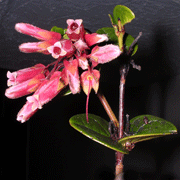James L. Luteyn and Paola Pedraza-Peñalosa
The New York Botanical Garden
|
|
Plutarchia A. C. Smith is a shrubby, neotropical genus of 10 species, almost totally restricted to the South American high montane cloud forest and subpáramo. In 1933, Smith segregated the genus from the related Thibaudia Ruiz & Pavón and Demosthenesia A. C. Smith. He distinguished it from Thibaudia by the strictly articulate calyx, presence of stipules, and staminal tubules 2-4 times longer than the thecae (vs. variable articulation, lack of stipules, and tubules more or less equal to thecae in Thibaudia). It differed from Demosthenesia by its articulate rather than continuous calyx, obprismatic rather than obconical calyx base, more compact and sclerophyllous habit, and distinct geographical range (Colombia for Plutarchia vs. Peru for Demosthenesia) (Smith, 1933). It was also superficially related to Cavendishia Lindley in that some species have large "cavendishioid" floral bracts and slightly alternately unequal stamens (cf. Luteyn, 1983). Six species were recognized when the Plutarchia was named (Smith, 1933). Between 1937 and 1952, two species were transferred to other ericaceous genera and five species were described as new, bringing to nine the number of species recognized -- all from Colombia. Recent collecting efforts, however, have extended the geographical range of the genus to Ecuador (Luteyn, 1992b). In general, the genus is poorly collected and relationships between species are not well understood. |
PLUTARCHIA A. C. Smith, Bull. Torrey Bot. Club 63: 311. 1936. Type: Plutarchia rigida (Benth.) A. C. Smith.
Compact, terrestrial shrubs. Leaves alternate to opposite or subopposite, usually petiolate, coriaceous, obscurely nerved. Inflorescences axillary, fasciculate, 1-8-flowered, often encircled at the base by few to many small to 2 cm long, bracts; floral bracts small to large and "cavendishoid"; bracteoles two. Flowers 4-5-merous, without odor; aestivation valvate; pedicellate, with the calyx articulate with the pedicel; hypanthium obprismatic and often abruptly contracted at the base, or terete to winged; limb erect, equal to hypanthium or 2-4 times longer, rarely shorter; lobes deltoid or lanceolate-deltoid, usually free to base of the limb, often proportionately long; corolla subcylindric, cylindric to urceolate-cylindric, terete or angled, the lobes small, triangular; stamens (5-)8-10, equal or unequal, about as long as the corolla; filaments distinct, equal or alternately slightly enequal, dorsally attached to the anthers near their bases, lacking spurs; anthers lacking disintegration tissue; thecae slightly granular; tubules 2-4 times longer than the thecae, flexible, dehiscencing by elongate clefts; ovary inferior; style subequal to corolla. Fruit a berry with numerous, small seeds.
Key to Neotropical Species Back to Top
A key and complete treatment is lacking, and this synthesis comes from Luteyn 1992b and 1996b, and other unpublished notes.
